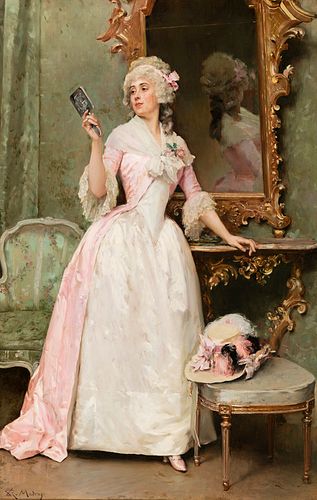RAIMUNDO DE MADRAZO Y GARRETA (Rome, 1841 - Versailles, 1920). "The vanity". Oil on panel.
Lot 84
About Seller
Setdart Auction House
Carrer Aragó 346
Barcelona
Spain
Setdart Subastas was born in 2004 and is currently the first online art auction in Spain with solidity, prestige and reliability guaranteed by our more than 60,000 users. Setdart has a young, dynamic and enterprising team ready to successfully manage the purchase and sale of art works through custom...Read more
Estimate:
EUR€45,000 - EUR€50,000
$48,387.10 - $53,763.44
Absentee vs Live bid
Two ways to bid:
- Leave a max absentee bid and the platform will bid on your behalf up to your maximum bid during the live auction.
- Bid live during the auction and your bids will be submitted real-time to the auctioneer.
Bid Increments
| Price | Bid Increment |
|---|---|
| EUR€0 | EUR€10 |
| EUR€200 | EUR€25 |
| EUR€500 | EUR€50 |
| EUR€1,000 | EUR€100 |
| EUR€3,000 | EUR€200 |
| EUR€5,000 | EUR€500 |
| EUR€10,000 | EUR€1,000 |
| EUR€20,000 | EUR€2,000 |
| EUR€50,000 | EUR€5,000 |
About Auction
By Setdart Auction House
Nov 10, 2021
Set Reminder
2021-11-10 08:00:00
2021-11-10 08:00:00
America/New_York
Bidsquare
Bidsquare : 19th & 20th Century paintings and Decorative Arts
https://www.bidsquare.com/auctions/setdart-auction-house/19th-20th-century-paintings-and-decorative-arts-7800
Setdart Auction House sofia@setdart.com
Setdart Auction House sofia@setdart.com
- Lot Description
RAIMUNDO DE MADRAZO Y GARRETA (Rome, 1841 - Versailles, 1920). "The vanity". Oil on panel. Presents stamp on the back and frame of the late nineteenth century: Signed in the lower left corner. Measurements: 101 x 67.5 cm; 124 x 89.5 cm (frame). Placed between two mirrors, the author presents us with an elegant, subtle and delicate protagonist. Dressed in her white and pink dress, the lady holds a small mirror in which she looks at herself, leaning on a console, on the furniture a large mirror reveals her back. This arrangement indicates that the woman is probably trying to check her headdress, after having removed the large hat resting on a stool. The qualities of the materials, the silk of the dress, the upholstery, the gilding of the mirror, denote the artist's interest in capturing the qualities and his technical skill that also extends to the way of conceiving the composition, demonstrating that this is a theoretical artist, with a great academic training. Son of Federico de Madrazo, Raimundo was taught by his father and grandfather, José de Madrazo y Agudo. He also studied at the Escuela Superior de Pintura y Escultura de Madrid, where his teachers were Carlos Luis de Ribera and Carlos de Haes. In 1860 he participated in the Universal Exposition in Paris, and two years later he settled in that city, where he attended the studio of Léon Cogniet and also attended courses at the School of Fine Arts and the Imperial School of Drawing. Madrazo spent most of his life in Paris, where he married and became a leading figure in the school of Spanish painters established there. During these years he carried out his first important commission, the decoration of the Parisian palace of Queen MarÃa Cristina with the canvas "Las Cortes de 1834", finished in 1865. He soon became one of the favorite painters of the Parisian upper class circles, especially for his facility for portraiture. His portraits would be portraits of aristocratic elegance, very soft modeling and sketchy backgrounds, of loose execution, as shown in works such as "Doña Josefa Manzanedo e Intentas de Mitjans, Marquise of Manzanedo" (1875) or "Ramón de Errazu" (1879), both now in the Prado Museum. As a portraitist he was one of the best of his generation, worthy successor of his father and author of a style of meticulous and elegant realism, sometimes frivolous but resolved with an irresistible decorative instinct, key to his success among the bourgeoisie of his time, always with an absolute mastery of pictorial resources and an enormously refined chromatic delicacy. Raimundo de Madrazo also cultivated the genre of customs, so much to the taste of the time, a painting of reigned decorative qualities, sometimes close to his brother-in-law Mariano Fortuny, with whom he painted in 1868 and 1872, the latter year in Granada. Raimundo de Madrazo also took part in official exhibitions, both of fine arts and of other types, and in the Universal Exhibition of Paris in 1889 he was awarded the first medal and honored with the appointment of officer of the Legion of Honor. However, it was never necessary for him to participate in the National Exhibitions of Fine Arts in Madrid, since from a very young age he enjoyed an enormous prestige supported not only by his surname, but especially by his extraordinary faculties for painting. A cosmopolitan artist, he traveled to Rome and London and, from the last decade of the 19th century, to the United States and Argentina, countries where his work was highly recognized. Author of historical canvases such as "Cortes de 1834", which he painted for the Parisian palace of Queen MarÃa Cristina de Borbón, he produced numerous works of interiors and genre scenes for the international market, and in his youth he decorated in fresco the façades of the Madrid church of Las Calatravas, paintings that are practically lost today.
- Shipping Info
-
In-house shipping available. Please inquire at admin@setdart.com.
-
- Buyer's Premium



 EUR
EUR CAD
CAD AUD
AUD GBP
GBP MXN
MXN HKD
HKD CNY
CNY MYR
MYR SEK
SEK SGD
SGD CHF
CHF THB
THB

















